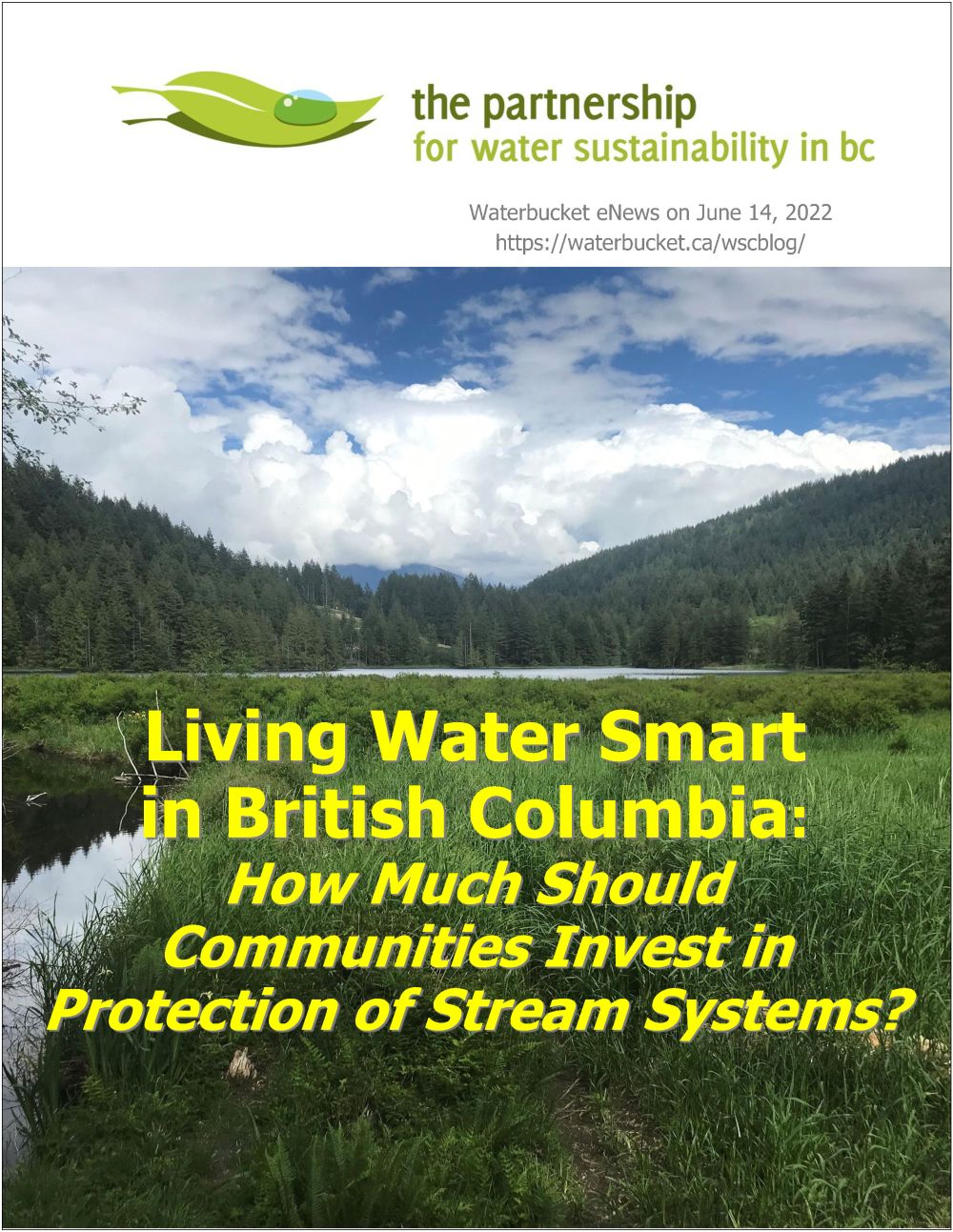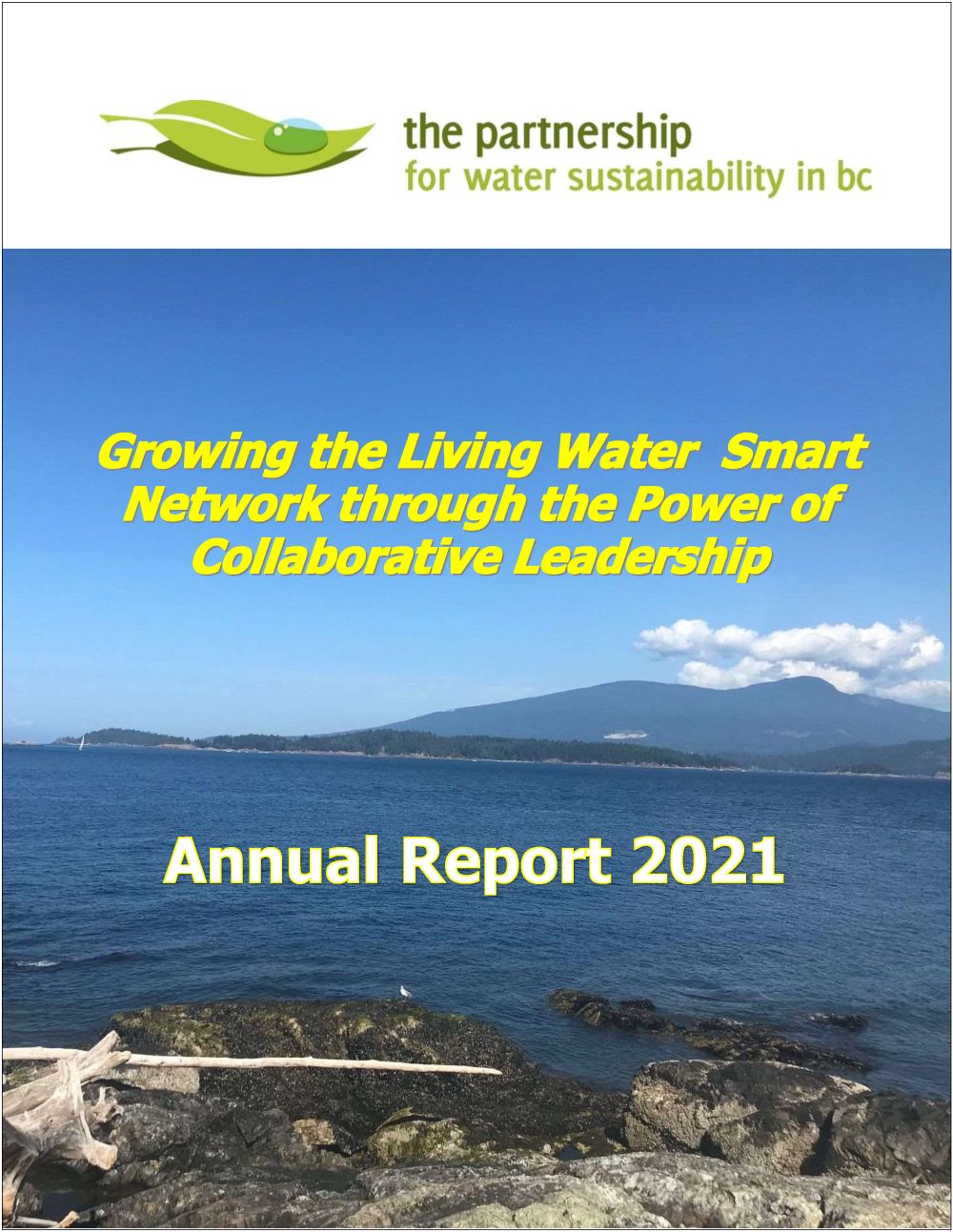How much should communities invest in protection of stream systems?

Note to Reader:
Waterbucket eNews celebrates the leadership of individuals and organizations who are guided by the Living Water Smart vision. Storylines accommodate a range of reader attention spans. Read the headline and move on, or take the time to delve deeper – it is your choice! Downloadable versions are available at Living Water Smart in British Columbia: The Series.
In the edition published on June 14, 2022, the Partnership announced release of its Synthesis Report on the 6-year program of applied research for testing, refining and mainstreaming the Ecological Accounting Process, a BC Strategy for Community Investment in Stream Systems.

Story behind the story of EAP, the Ecological Accounting Process
Know your history. Understand the context. These are key thoughts, and they provide perspective for the story of EAP, the Ecological Accounting Process, as told in Beyond the Guidebook 2022: EAP, a BC Strategy for Community Investment in Stream Systems, released on June 14, 2022 by the Partnership.
EAP uses real numbers. The methodology and metrics allow local governments to make a convincing financial case for annual investment in stream systems. The next step for them is to integrate budget line items for stream maintenance and management (M&M) into their Asset Management Strategies.
The “EAP story” is about a journey, one that began circa 1990 for pioneers working on parallel stream protection and restoration initiatives in British Columbia and Washington State. Three decades later, these parallel tracks have converged in the form of EAP. It has been a building blocks process requiring commitment, patience, and perseverance by many.

Local governments now have a path forward to address the Riparian Deficit. This is the environmental equivalent of the Infrastructure Funding Gap. It puts the environmental perspective on an equal footing with the engineering and accounting perspectives. This alone is game-changing.
The growing cost due to neglect of the Drainage Service, combined with the urgency of the drainage liability issue, is the driver for linking municipal infrastructure asset management and stream health as “cause-and-effect”.

Beyond the Guidebook Series
Stormwater Planning: A Guidebook for British Columbia, released in 2002, is the foundation document for the Beyond the Guidebook Series of guidance documents. The titles themselves tell a story about the partnership journey in building on the Guidebook through case studies that showcase and celebrate good work, and advance implementation of science-informed approaches.
Context for Rainwater Management and Green Infrastructure in British Columbia (2007)
Implementing a New Culture for Urban Watershed Protection and Restoration in British Columbia (2010)
Moving Towards “Sustainable Watershed Systems, through Asset Management (2015).
Ecological Accounting Process, A B.C. Strategy for Community Investment in Stream Systems (2022) – the Synthesis Report is a distillation of over 1000 pages of case study documentation into a storyline that is conversational and written for a continuum of audiences that includes land use practitioners, asset managers, stream stewards, and local government decision-makers.
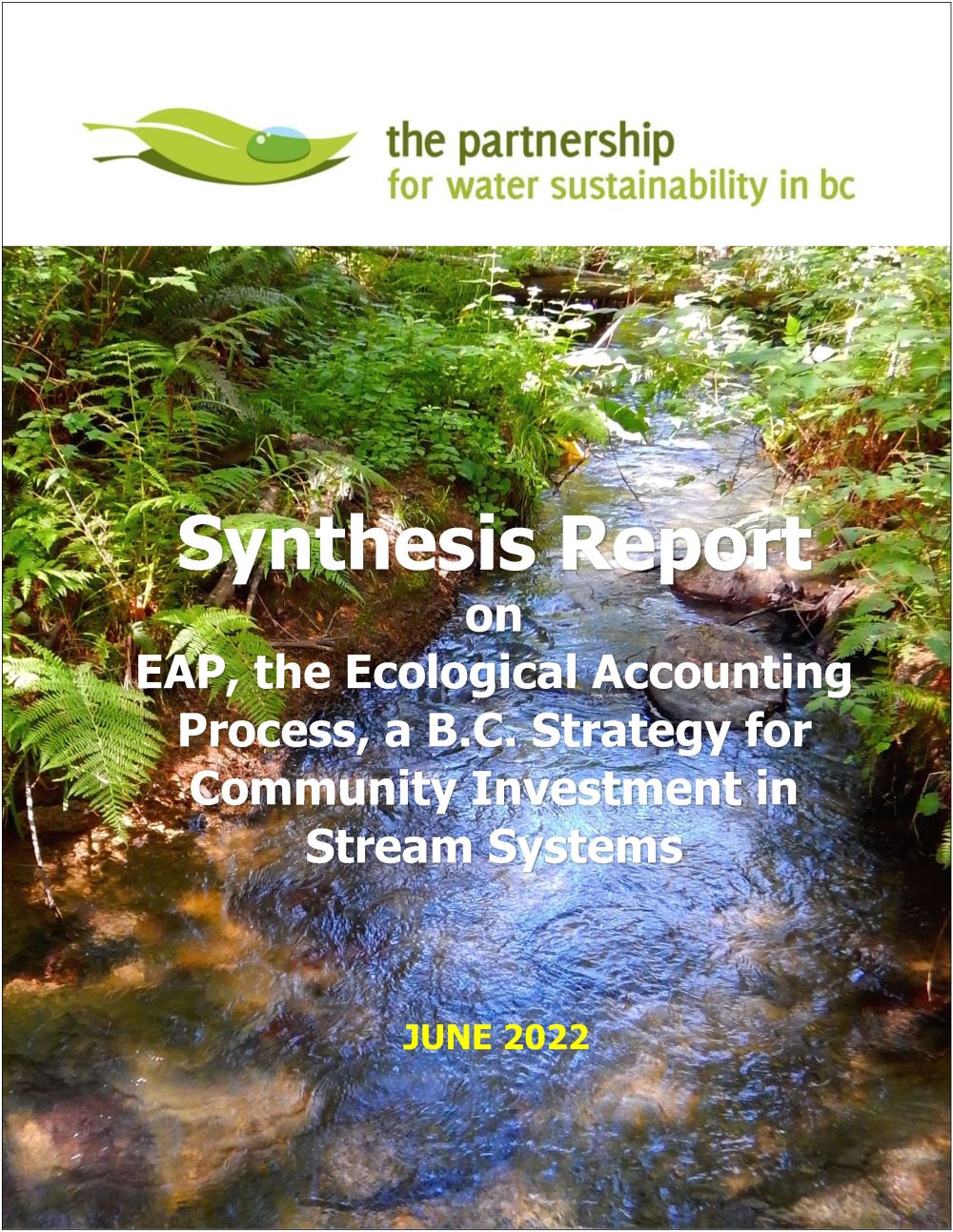
DOWNLOAD A COPY OF https://waterbucket.ca/gi/wp-content/uploads/sites/4/2022/06/EAP-Synthesis-Report-Beyond-the-Guidebook-2022_Jun-2022.pdf
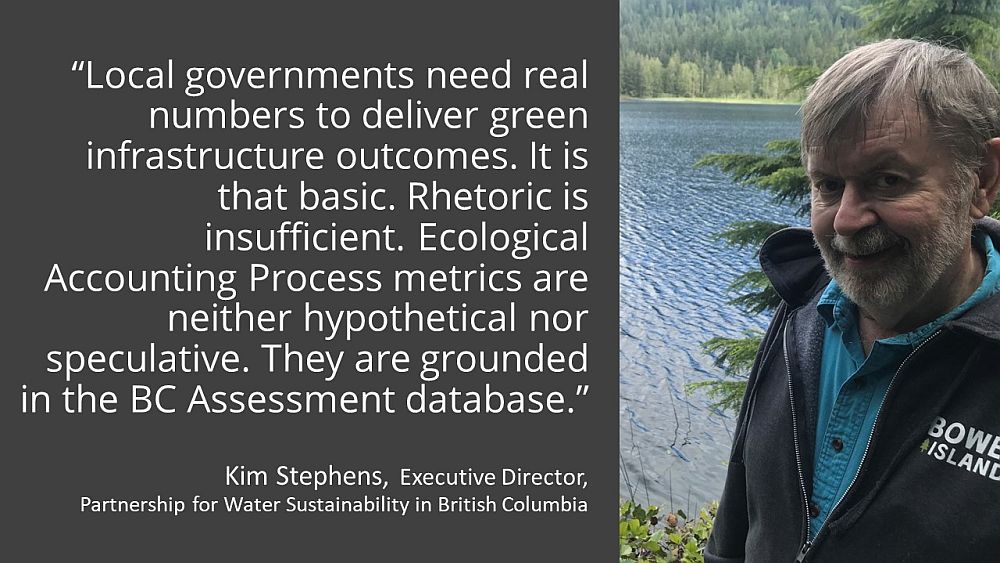
EDITOR’S PERSPECTIVE
“If we know how to do a much better job of protecting ecological features and stream systems in our communities and on our landscape, then why aren’t we doing a better job? Why are streams still degrading? Why do we still see practices that exacerbate the situation? Why is understanding lacking? How do we change that?” stated Kim Stephens, Waterbucket eNews Editor and Partnership Executive Director.
“An elephant in the room is the hollowing out of government capacity at all levels and the reliance on outside service providers. The ramifications of this dual concern provide the context for the Partnership’s observation that a lack of understanding of the science behind the Twin Pillars of Stream System Integrity, and especially that a stream is a system, is widespread.”

“Following publication of Beyond the Guidebook 2015, the Partnership embarked on a 6-year program of applied research to evolve and operationalize the EAP methodology and metrics through collaboration with willing local governments. The program involved 9 case studies and 13 local governments and yielded 19 ‘big ideas’ or foundational concepts,” continued Kim Stephens.
“EAP evolved as one big idea’ led to the next one. We could not have made the leap directly from the first to the last. It required a building blocks process. This is the beneficial outcome of a systematic approach to applied research that tests and refines the methodology and metrics to get them right, and is founded on the principle of collaboration that benefits everyone.”
“With the perspective of hindsight, each local government took a leap of faith that EAP would fit into their strategic directions. Now, with EAP as a foundation piece, these local governments have a rationale and a metric to do business differently via multiple planning pathways to achieve the goal of ‘natural asset management’.”

“The Drainage Service is the neglected service, and the cost of neglect grows over time. Until now, local governments have lacked a pragmatic methodology and meaningful metrics to incorporate stream systems as line items in Asset Management Strategies. For local governments wishing to move from stopgap fixes to long-term solutions, EAP gives them a road map.”
“Local governments need real numbers to deliver green infrastructure outcomes. It is that basic. Rhetoric is insufficient. EAP metrics are neither hypothetical nor speculative. They are grounded in the BC Assessment database. EAP is a foundation piece for Asset Management for Sustainable Drainage Service Delivery,” concluded Kim Stephens.
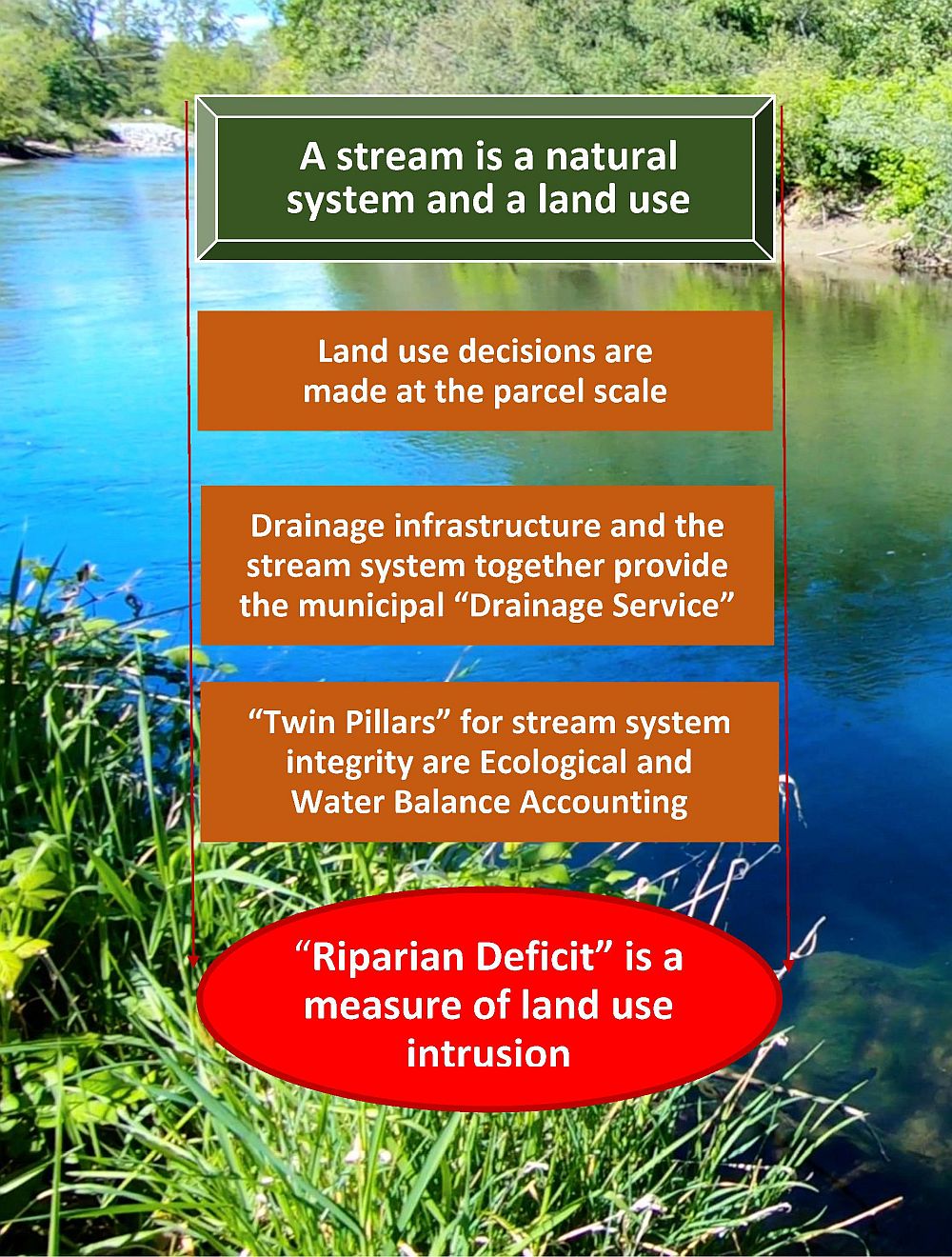
The story behind the story of “EAP, A BC Strategy for Community Investment in Stream Systems”
Master drainage planning, integrated stormwater planning, and other processes at best pay lip-service to the role of the streamside protection zone within a stream system context, the condition of native vegetation and woodlands cover, and the need for restoration.
Now, EAP provides the reason to ask the question, why aren’t these factors considered and given equal weight to engineering considerations?
To overcome barriers to learning and uptake, Beyond the Guidebook 2022 is written as a “story behind the story” with the objective of inspiring readers to apply their new-found insights about the science of land use change. Allow sufficient time to read and absorb each of the six parts that comprise “the story of EAP”. Appreciate why the Riparian Deficit is a game-changing concept.
“It is amazing that we have been able to produce a methodology that defines what a stream is, can find the value of the stream using impartial BC Assessment data, and add to that a riparian assessment that looks at the 30m zone and a further 200m upland area to evaluate the water balance condition and what is happening to water pathways,” says Tim Pringle, EAP Chair.
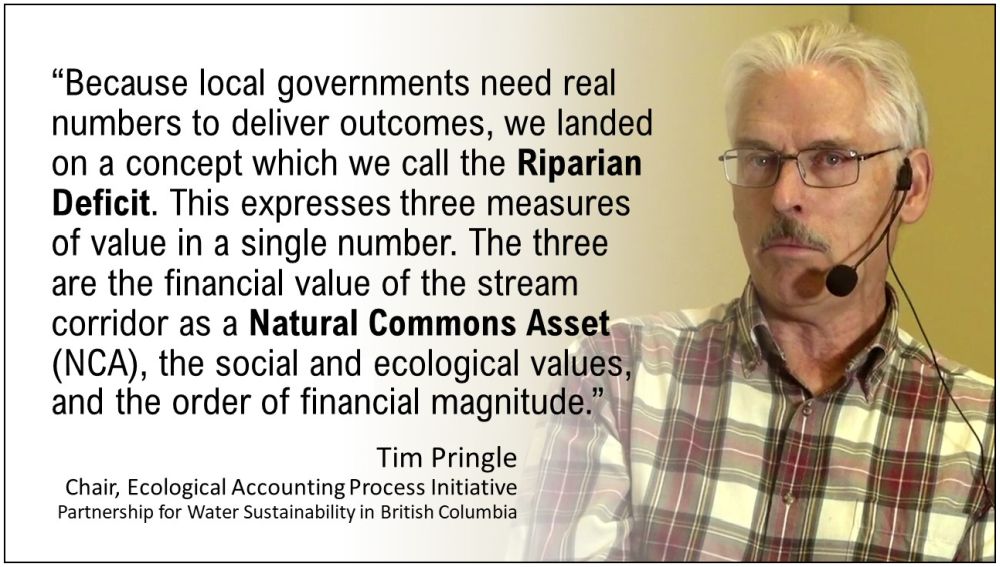
The Story of EAP in Six Parts (click on the titles)
Financial Case for the Stream – Executive Summary
Part A – Synopsis for the Busy Reader
Part B – Story Behind the Story of Sustainable Drainage Service Delivery
Part C – Case Study Building Blocks Process
Part D – Hydrology is the Engine that Powers Ecological Services
Part E – A Stream is a Land Use

Addressing the Elephant in the Room
In the 1990s, the breakthrough in science-informed understanding was the Road Map for Stream System Integrity. For the past generation of practice, communities should have known what they ought to be doing. And some have made progress. But, in the big picture, the last two decades have been characterized by an inability to act on the science. The consequence is a growing Riparian Deficit which is an unfunded liability.
Having arrived at the EAP destination, the Riparian Deficit, the Partnership is able to reflect on the two issues which provided context for the journey: first, engineering measures are insufficient for stream and riparian protection; and secondly, the link to municipal asset management has not been clear.
To reach the destination, the Partnership had to address and show how to overcome four challenges: one, a lack of measurable metrics; two, confusion over what is an asset versus a service; three, ignorance about how to quantify the financial value of “natural assets” with real numbers; and four, numerous “one-off” projects that fail to build improved asset management practice.

Interdepartmental communication
An elephant in the room is the question of how to create a situation where the environmental perspective is on an equal footing with the engineering and accounting perspectives.
Only then can there be an effective conversation about annual budgets for maintenance and management (M&M) of assets, whether those are constructed assets or the natural component of the Drainage Service.
For an inter-departmental conversation to be outcome-oriented, there must be a real number to focus attention on what is at stake. The Riparian Deficit is that metric. It enables local government to pose and answer the question:
What will change when EAP analyses provide financial values for natural assets such as streams?

What / So What / Now What / Then What
A decade ago, the Partnership was hopeful that all players would embrace shared responsibility and communities would move from stopgap fixes to long-term restoration of properly functioning streams. We are not there yet, in large part because of the hollowing out of government capacity at all levels and the reliance on outside service providers.
In view of the myriad of realities currently facing all organizations, the task of rebuilding local government understanding and capacity to protect stream system integrity will take time, energy, and long-term commitment. The asset management task is two-fold in scope.
One, influence current practitioners to adopt EAP into asset management strategies. Two, train the next generation of land use, GIS, and drainage professionals in the use of EAP. This starts in university.
With completion of the current program to mainstream EAP through case studies, the Partnership has set a process in motion to embed EAP in a university setting to support the work of local government practitioners.
The image below conceptualizes the 4-step process to fully operationalize EAP. In collaboration with willing local governments, we are in transition from Step Two (So What can be done) to Step Three (Now What can we do).

Did you enjoy this article? Would you like a PDF document version? Waterbucket News feature stories are published online as part of the Living Water Smart Series. Click on the image below to download your copy.
DOWNLOAD A PDF COPY: https://waterbucket.ca/wcp/wp-content/uploads/sites/6/2022/06/PWSBC_Living-Water-Smart_EAP-Synthesis_2022.pdf
About the Partnership for Water Sustainability in BC
Technical knowledge alone is not enough to resolve water challenges facing BC. Making things happen in the real world requires an appreciation and understanding of human behaviour, combined with a knowledge of how decisions are made. It takes a career to figure this out.
The Partnership has a primary goal, to build bridges of understanding and pass the baton from the past to the present and future. To achieve the goal, the Partnership is growing a network in the local government setting. This network embraces collaborative leadership and inter-generational collaboration.
TO LEARN MORE, VISIT: https://waterbucket.ca/about-us/
DOWNLOAD: https://waterbucket.ca/atp/wp-content/uploads/sites/9/2021/11/PWSBC_Annual-Report-2021_version-for-waterbucket.ca_.pdf


